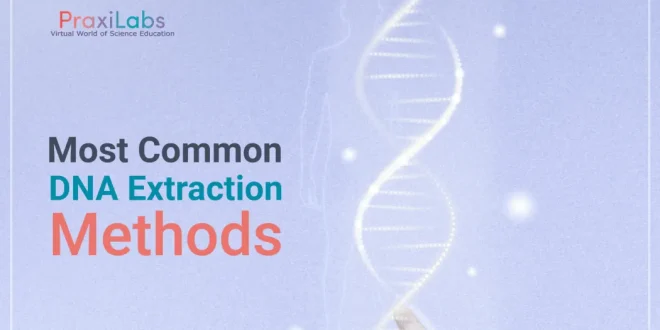Last Updated on October 19, 2025 by Muhamed Elmesery
DNA extraction is one of the basic techniques employed in the molecular laboratory, done for the first time by Friedrich Miescher in 1869.
In this article, we will focus on DNA extraction methods, comparing methods for more understanding. Along with this, we will explain DNA extraction protocol, DNA extraction experiment, and advantages DNA extraction methods.
Although Friedrich Miescher isolated the cell material “nuclei” or “nucleic acid” and developed a method for nucleic acid isolation, he was not sure whether what he isolated was DNA or not.
In 1958 Stahl and Meselson developed a full-function protocol for DNA extraction (The density gradient centrifugation protocol) that was the first protocol described for isolating DNA from E.coli bacteria.
Try DNA Extraction Now For FREE
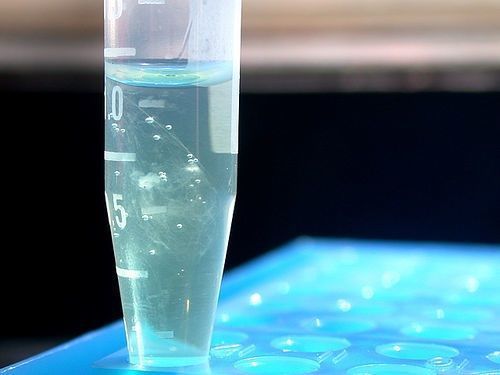
Table of Contents
What is DNA Extraction ?
DNA extraction is a process that used to purify DNA by using chemical or physical methods from a biological sample separating DNA from protein, cell membranes, and other cellular components.
DNA extraction protocol involves lysis of membranes for DNA extraction, then separating DNA from impurities like proteins, and other substances.
What is DNA Extraction Principle?
DNA extraction involves lysis of cellular and nuclear membranes in order to extract DNA from within. This is followed by DNA separation from impurities, proteins, and other substances.
General Stages of DNA Extraction are:
- Cell dissolution: lysis of cell and the nucleus to extract DNA into the buffer.
- Precipitation: removing the impurities and proteins from the sample.
- Purification: This final stage is done to get a completely pure DNA sample ready to be used.
Note: the main steps remain similar among all DNA extraction methods.
For more information about DNA extraction, visit our article “DNA Extraction Virtual Lab Experiment from PraxiLabs”
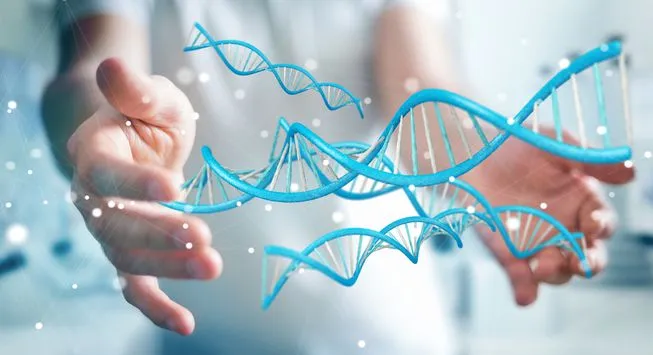
Different Types of DNA Extraction Methods
Depending upon the sample type, every DNA extraction method varies (there are different ways to extract DNA), for example, the DNA extraction method for plant DNA is different from DNA extracted from blood . Likewise, the bacterial DNA isolation method is different from other types. So, varieties of DNA extraction methods are needed for different samples. Let’s compare and contrast different DNA extraction methods and then you can choose the best DNA extraction method for your project!
DNA extraction methods are broadly categorized into:
- Chemical-based (or solution- based) DNA extraction methods.
- Solid-phase DNA extraction methods (Physical method).
Create FREE Account To Try The Experiment Now
Chemical-based DNA extraction method
The Chemical or solution-based method uses many organic and inorganic solutions. Chemicals like phenol, chloroform, CTAB Triton X100, SDS, isoamyl alcohol, Tris and EDTA are used in the chemical -based DNA extraction method.
The solution-based or chemical-based DNA extraction method is subdivided into:
- Organic solvent-based DNA extraction
This method depends on the use of organic substances such as phenol and chloroform.
Example: Phenol-chloroform and isoamyl alcohol
- Inorganic solvent-based DNA extraction
It depends on the inorganic solvents.
Examples:
- Proteinase K DNA extraction.
- Salting out method.
- SDS DNA extraction.
- CTAB DNA extraction.
- Silica-gel-based techniques.
Physical or Solid-Based DNA Extraction Methods
- Paper DNA extraction.
- Magnetic bead DNA extraction.
Liquid-Liquid DNA Extraction
Liquid-liquid extraction is one of the commonest methods for nucleic acid extraction. In this method the solutions prepared by various chemical compositions are used for extraction and it mainly relies on lysis buffer preparation.
Lysis buffer is prepared in one or two solutions as it uses many chemicals. Common chemicals that used for liquid-liquid DNA extraction are Phenol, chloroform, isoamyl alcohol, CTAB, SDS, Tris, EDTA, MgCl2, and other detergents.
These methods commonly require centrifugation for separation. Examples of liquid-liquid DNA extraction methods: Phenol, chloroform and isoamyl alcohol DNA extraction, SDS DNA extraction and CTAB DNA extraction.
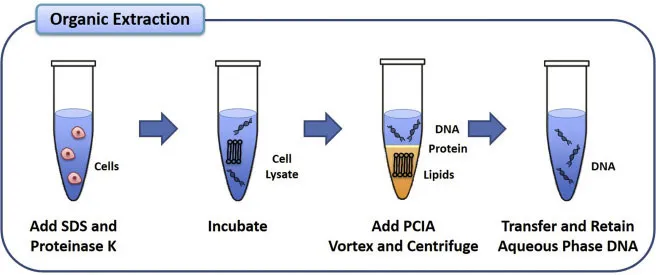
Comparison of DNA Extraction Methods
Phenol-Chloroform Method
In this method we can separate the DNA based on the solubility of DNA molecules in immiscible solutions, and that is called the liquid-liquid DNA extraction methods (the phenol chloroform DNA extraction method is one of these methods).
Although this method is considered one of the best methods, it is less recommended because of phenol and chloroform harmful. The quantity and quality of DNA obtained by method are very good.
This method is known as a phenol-chloroform and isoamyl alcohol or PCI method of DNA extraction.
The major chemicals of PCI DNA extraction methods are Phenol, chloroform and lysis buffer (contains EDTA, Tris, NaCl, MgCl2, SDS, and other salts).
The organic component of the technique- phenol and chloroform denature the protein portion of cells and lysis buffer components help in the cell membrane and nuclear lysis.
The lysis buffer contains salts like EDTA, NaCl, Tris and SDS.
In principle, the phenol digests proteins, isoamyl alcohol separates nucleic acid and chloroform reduces the foaming between interphase.
The main advantage of the PCI is that it can isolate DNA from nearly all tissue types (It works for animal, plant and bacterial cells) and it can isolate RNA when used with guanidine thiocyanate.
Unfortionatly, this method is it is unsafe because Phenol is volatile and can cause burns. the chloroform can faint us. So, it requires training and to prepare and handle chemicals.
PraxiLabs provides the DNA extraction experiment at our biology virtual lab that based on the phenol chloroform extraction method … Subscribe and try it now
Proteinase K DNA Extraction
The proteinase K-based method is one of inorganic solution-based technique for DNA extraction.
The proteinase K DNA extraction method provides high quantity of DNA but thee disadvantage of this method is that takes long time. Also, in case of not maintained well in a cold chain, the enzyme proteinase K cannot be utilized for a longer period of time. Another major problem is that The stability of the enzyme is low.
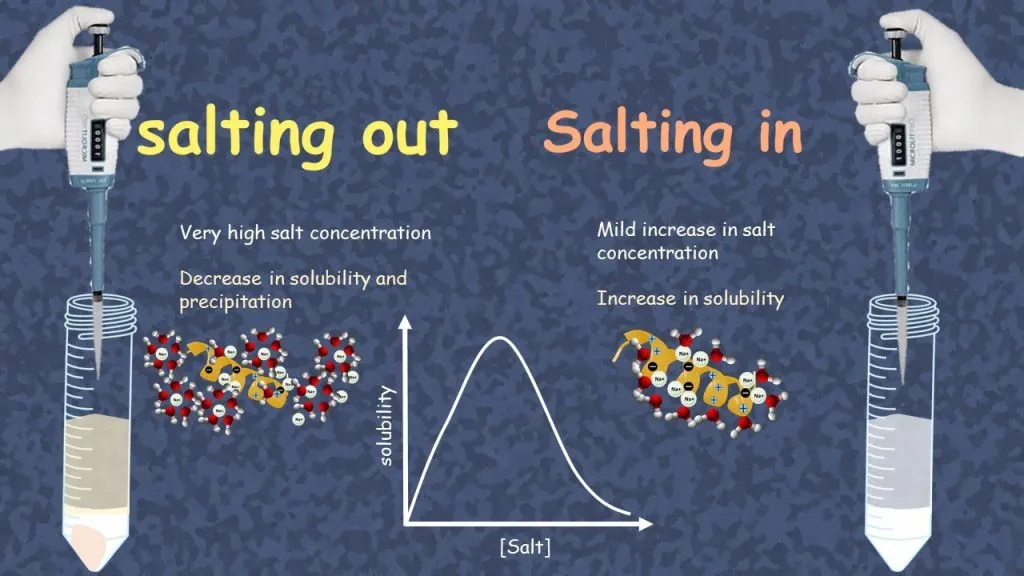
The Salting-out DNA Extraction
Extraction method is a simple and non-toxic technique that isolates a high-quality DNA from the whole blood. In the standard salting-out method, proteins K and RNase are added to them after the lysis of cells. Saturated NaCl was needed for the proteins to precipitate out of the solution. The cell samples are centrifuged and then, DNA is separated by washing it with detergent like ethanol.
The salting-out DNA extraction method is safer than the phenol-chloroform method. It depends on the usage of salts such as potassium acetate, sodium chloride, and ammonium acetate that help in DNA extraction.
This method gives excellent results in combination with proteinase K and enough yield can be obtained but the quality (purity) obtained might not be good.
SDS DNA Extraction
SDS or sodium dodecyl sulfate is an anionic detergent that digests nuclear and cell membrane proteins.
SDS gives a negative charge to each protein as a function of their size. Because all of proteins have the same shape in the gel separation they are separated only for their size. So, SDS can be used to aid in lysing cell during DNA extraction.
CTAB DNA Extraction
CTAB or Cetyl Trimethyl Ammonium Bromide is a chemical often used in DNA extraction. This method is a specially prepared liquid-liquid and solution-based extraction method for plant DNA extraction.
The CTAB buffer removes polysaccharides and polyphenols effectively and gives excellent yield for plant DNA.
This method required extensive chemical preparation and additional techniques like tissue homogenization and the use of liquid nitrogen. It also takes a long time.
Silica Gel Based Techniques
In the spin-column DNA extraction technique, a silica gel as a solid phase is immobilized in a tube. A specially prepared lysis buffer is used to digest the sample and allows it to separate on a solid phase. the sample is Centrifuged first to remove all the debris by protecting the DNA and changing the pH of the solution(to elutes DNA in the last step). these techniques are now commercially available.
Spin column is the most advanced, effective, rapid and accurate separation technique. It is, however, a chemical method of DNA extraction but works on the principle of solid-phase separation.
The main advantage of this technique is that can isolate DNA from any biological sample and tissue. However, it is difficult to isolate DNA from plants even using the spin-column technique, Different columns are now available depending upon the sample type.
But this technique is Cost, lacks optimizations and the yield remains comparatively low but good.
Home DNA extraction | How to Extract Your Own DNA at Home
Let’s try one of simple DNA extraction methods (DIY DNA extraction)!
To do DNA Extraction experiment at home you will need:
- Zip lock bag (heavy duty).
- 3 fresh strawberries.
- 1 pinch of table salt (NaCl).
- 8 drops of shampoo (without conditioner).
- Strainer.
- Ice- cold isopropyl rubbing alcohol.
- Small clear glass or test tube.
- Large paper clip, straightened out.
Steps:
- Wash the strawberries and remove the sepals (the green leaves)
- Place the strawberries in a zip lock plastic bag and crush it with your fist
- Add the salt and shampoo to the mashed strawberry mixture in the bag, zip it up and squeeze it in your hands for 1 minute.
- Place the strainer over the small glass.
- Pour the strawberry shampoo mixture into the strainer. Filter the mixture into the glass.
- Slowly pour ice cold rubbing alcohol into the glass, until it is about half full.
- The alcohol will form a separate layer on top of the strawberry filtrate.
- Keep the glass still at eye level; do not shake it. Watch what happens. DNA will begin to appear where the alcohol and filtrate layer meet.
- Carefully scoop out the DNA with the straightened end of the paper clip.
- Now you can observe what the DNA looks like and what it feels like
- Discard the mashed strawberries and solution. Wash your equipment and clean your experiment area, and wash your hands!
Advantages of DNA Extraction Methods
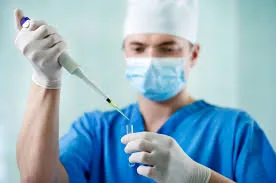
- DNA extraction is vital to biology, especially biotechnology. It is the first step of different applications like fundamental research, disease diagnosis and therapeutic decision.
- One of the main advantages of DNA extraction methods is that they are very importance to define the unique characteristics of DNA like the shape, the size and function.
- DNA extraction is used in medical conditions investigation such as Down syndrome and cystic fibrosis. It is also helpful in case of identification if a person is a carrier of the disease or not. So, by DNA sequence in relation to diseases, It helped in finding out the molecular basis and cure for various diseases.
- In criminal investigations, DNA extraction from samples (e.g., hair – skin – blood) is used to determine if a person is a suspect or not and also it can prove whether a person was in the vicinity of the crime scene.
- It also used in Paternity Tests.
- It can be useful in genetic engineering. For animals, DNA extraction is helpful for transforming and cloning animal’s DNA. For plants, DNA can be useful in identifying and extracting a specific gene in order to replicate in generations of plants.
- DNA study also helped in creating many vaccines (e.g., Hepatitis B vaccine), hormones (e.g., growth hormones and insulin), and enzymes.
- We can use extracted DNA for PCR experiments, DNA can be amplified with the help of PCR.
DNA Extraction Experiment from PraxiLabs
PraxiLabs provides DNA extraction lab that used to extract cellular DNA using phenol/chloroform method.
The following video shows the steps of DNA extraction in the virtual lab:
By the end of the experiment, students are able to understand one of the DNA extraction methods as well as efficiently deal with the protocol involved in DNA extraction in a safe environment with the ability to repeat the experiment an unlimited number of times at any time and from anywhere.
The Procedures Of DNA extracted virtual labs
DNA extraction lab from PraxiLabs depends on one of the most popular DNA isolation techniques that includes the following steps:
- Prepare 10 microliters of RNAse enzyme and add it to the sample .
- Add 700 microliters of cell lysis buffer to the sample.
- Place the sample in the water bath at 37 degrees Celsius for an hour.
- Add 10 microliters of the Proteinase K enzyme and mix it with the sample several times with the pipette.
- Mix the sample well with the vortexer for 15 seconds. (Note: Avoid creating bubbles in the sample.)
- Place the sample in the water bath at a temperature of 56 degrees Celsius for two hours.
- Add 700 microliters of Phenol, Chloroform,and isoamyl alcohol in the ratios of 25:24:1, and pipet up and down several times to mix the solution with the sample using a pipette.
DNA Isolation
- Place the sample in the centrifuge and set it to 13,000 rpm for 10 minutes at a temperature of 4 degrees Celsius to isolate the contents of the tube to two layers. (Note: To balance the centrifuge a tube of the same size filled with water must be added to the opposite side of the sample tube.)
- Remove the top layer using the pipette, then place it in a clean tube.
- Repeat steps 7, 8, and 9 twice.
- Add 700 microliters of Chloroform to the sample you have removed.
- Place the sample in the centrifuge and set it to 13,000 rpm for 10 minutes at a temperature of 4 degrees celsius to isolate the contents of the tube to two layers. (Note: To balance the centrifuge a tube of the same size filled with water must be added to the opposite side of the sample tube.)
- Remove the top layer using the pipette, then place it in the clean tube.
- Repeat steps 12 and 13 once more .
- Add a solution of sodium acetate with a concentration of 3 Molar, a tenth of the volume of the sample, to the sample.
- Add an ethanol solution with a concentration of 95%, twice the volume of the sample, to the sample.
- Mix the contents of the tube by inverting it. Then leave it to precipitate at a temperature of – 70 degrees Celsius for a whole day.
- Place the sample in the centrifuge and set it to 13,000 rpm for 30 minutes at a temperature of 4 degrees Celsius. (Note: To balance the centrifuge a tube of the same size filled with water must be added to the opposite side of the sample tube.)
- Pour the supernatant into a wastebasket. Retrieve the remaining material using a pipette gently so as not disturb the pellet.
- Add 700 microliters of 70% ethanol. Then mix it by flicking it gently to prevent damage.
- Place the sample in the centrifuge and set it to 13,000 rpm for 10 minutes at a temperature of 4 degrees Celsius. (Note: To balance the centrifuge a tube of the same size filled with water must be added to the opposite side of the sample tube.)
- Pour the liquid into the wastebasket, and the remaining is removed using the pipette gently to not disturb the pellet.
- Dry the sample in the air.
- Dissolve the DNA sample in TE buffer and mix it with the sample several times using the pipette.Note: Now you have a DNA sample and can use it in other operations
Try the virtual lab of educational DNA extraction simulation now
DNA Extraction Done Right: A Guide to Safe and Responsible DNA Extraction Practices
- Wear appropriate protective clothing.
- Keep biological agents in the correct areas to minimize exposure to risk.
- Disinfect work surfaces and properly dispose of waste.
- Prevent the spread of contamination or spills.
- Make sure that you know the importance of sanitizing your desk space as it is an effective way to ensure a clean and safe work environment.
- Wear the laboratory coat while working in the lab.
- Avoid consuming or storing food and beverages in the laboratory.
- Make sure that you know the location of and how to use emergency equipment, including safety showers, eyewash stations, and medical cabinet.
- Ensure that your work area has proper ventilation to prevent the build-up of unwanted or harmful substances.
- Cleaning the work area with medical-grade sanitizing products is important.
Factors to consider while choosing the suitable method for your DNA extraction:
You can choose the best DNA extraction method for your project by checking the following factors:
- The type of Sample: each type of sample (Bacteria, animal tissue , plants , water, blood , soil, saliva) requires a specific method to extract the DNA. Your type of sample is in fact the most crucial factor to consider when selecting a DNA extraction method.
- Plasmid DNA vs Genomic DNA: The protocol for plasmid DNA isolation is different from the one used to isolate the genomic DNA. The difference is mainly in the lysis process, and some buffer formulations.
- Downstream applications: The quality and purity of extracted DNA must fulfill the requirements of the downstream applications.
- Sample quantity: Some methods are designed specifically for a certain amount of sample.
- Yield: The DNA extraction method you choose should meet the yield expectations for your purpose.
DIY DNA extraction | Home DNA extraction
The following method is one of the easy DNA extraction methods for beginners, you will need DNA sources such as Spinach, Chicken liver, Strawberries, or Broccoli.
In this experiment we will use green split peas.
Step 1: Blender Insanity!
Put in a blender:
- 1/2 cup of split peas (100ml).
- 1/8 teaspoon of table salt (less than 1ml).
- 1 cup cold water (200ml).
Blend on high for 15 seconds. The blender separates the pea cells from each other, so you now have a very thin pea-cell soup.
Step 2: Soapy Peas
- Pour your thin pea-cell soup through a strainer into another container (like a measuring cup).
- Add 2 tablespoons of liquid detergent (about 30ml) and swirl to mix.
- Let the mixture sit for 5-10 minutes.
- Pour the mixture into test tubes or other small glass containers, each about 1/3 full.
Step 3: Enzyme Power
- Add a pinch of enzymes to each test tube and stir gently. Be careful! If you stir too hard, you’ll break up the DNA, making it harder to see.
- Use meat tenderizer for enzymes. If you can’t find tenderizer, try using pineapple juice or contact lens cleaning solution.
Step 4: Alcohol Separation
Tilt your test tube and slowly pour rubbing alcohol (70-95% isopropyl or ethyl alcohol) into the tube down the side so that it forms a layer on top of the pea mixture. Pour until you have about the same amount of alcohol in the tube as pea mixture.
Alcohol is less dense than water, so it floats on top. Look for clumps of white stringy stuff where the water and alcohol layers meet.
The salt that you added in step one helps it stick together. So what you see are clumps of tangled DNA molecules!
DNA normally stays dissolved in water, but when salty DNA comes in contact with alcohol, it becomes undissolved. This is called precipitation. The physical force of the DNA clumping together as it precipitates pulls more strands along with it as it rises into the alcohol.
You can use a wooden stick or a straw to collect the DNA. If you want to save your DNA, you can transfer it to a small container filled with alcohol.
DNA Extraction Demystified: Common Questions Answered!
What is the DNA extraction process?
The extraction or isolation of DNA is the process of breaking open the cell and the nucleus to extract the DNA from within, then isolating it from impurities, proteins, and other substances.
The main stages of DNA Extraction involve:
- Cell lysis: In this stage the cell and the nucleus are broken open to extract a DNA sample.
- Precipitation: In this stage, proteins and impurities are removed from the sample.
- Purification: This stage involves isolating the DNA completely from the other substances, for a pure DNA sample.
What are the two main types of DNA extraction?
The two main types of DNA extraction are:
- Chemical-based (or solution- based) DNA extraction methods.
- Physical DNA extraction methods (solid-phase DNA extraction methods).
What are the three basic steps for DNA extraction?
Cell lysis: In this stage, the cell and the nucleus are broken open to extract a DNA sample.
Precipitation: In this stage, proteins and impurities are removed from the sample.
Purification: This stage involves isolating the DNA completely from the other substances, resulting in a pure DNA sample.
What are five facts about DNA extraction?
- If all the DNA stored within your body was placed side by side in a chain, it would be 600 times longer than the distance from the Earth to the Sun and back.
- Scientists did not know DNA contained genes until 1943. Prior to that ,they believed that genes were stored in proteins.
- Human DNA is 98% identical to that of a chimpanzee while it is 40-50% identical to that of a cabbage.
- Humans share 99.9% of their DNA code. The remaining 0.1% is responsible for the differences between us.
- If you could write 60 words per minute, and you continued to work 8 hours a day, it would take 50 years to write the human genome.
What are some challenges in extracting DNA?
- Not enough DNA quantity.
- Samples not mixed well enough during extraction.
- Proteinase K enzyme is inactive because it was prepared too far in advance.
- Water baths are not at the proper temperature.
PraxiLabs Molecular biology simulations
PraxiLabs simulations provide several features for more personalized learning such as:
- The progress report: allows teachers to see how well their students are doing, track their progress in each experiment, and gain insights into their performance. It also shows any stages that have been skipped during the experiment.
For example: DNA extraction has 3 stages. The feature captures any stages that have been skipped by the student in each attempt. It helps to know the number of times the student has asked our lab partner “Oxi” to know the next step and the last step that the student stopped at, helping to identify students who may be struggling with certain steps or who might need more help in order to complete the experiment.
- Input for Pipette & Observation Table: You can get the support you need instantly, if you forgot the right amount you need to enter or if data is entered incorrectly ( e.g., for the pipette or the observation table, at any point. The virtual assistant Oxi will alert you to any mistakes.
- Skipping ahead: Brings students a more user-centered, focused, and personalized learning experience. Students can skip certain experiment steps if they are already familiar with them. A list of the experiment milestones will allow them to select and focus on the stages they want to understand better.
We provide a diverse catalog of virtual biology practical simulations, allowing students to practice the same virtual biology practical simulation an unlimited number of times, with 0% risk and 100% supervision, across various sub-disciplines of biology:
Here are some examples of molecular biology virtual lab experiments available:
- DNA Extraction
- RNA Extraction
- cDNA Synthesis
- Conventional PCR
- Real Time PCR
- Agarose Gel Electrophoresis
- DNA fingerprinting using Gel Electrophoresis
- Bacterial Plating Out Technique Experiment (streak plate method)
- Antibiotic Sensitivity Test Disc Diffusion Method
- Coagulase Test
- Catalase Test
- Oxidase Test
- Indole Test
- Spread Plate Technique
2D Protein Electrophoresis(Isoelectric Point Focusing,PAGE)
Protein Electrophoresis (Polyacrylamide Gel Electrophoresis-PAGE)
On PraxiLabs, you can find different virtual biology simulations accessible anytime and anywhere. Subscribe and Get Started Now!
 PraxiLabs A virtual world of science
PraxiLabs A virtual world of science

